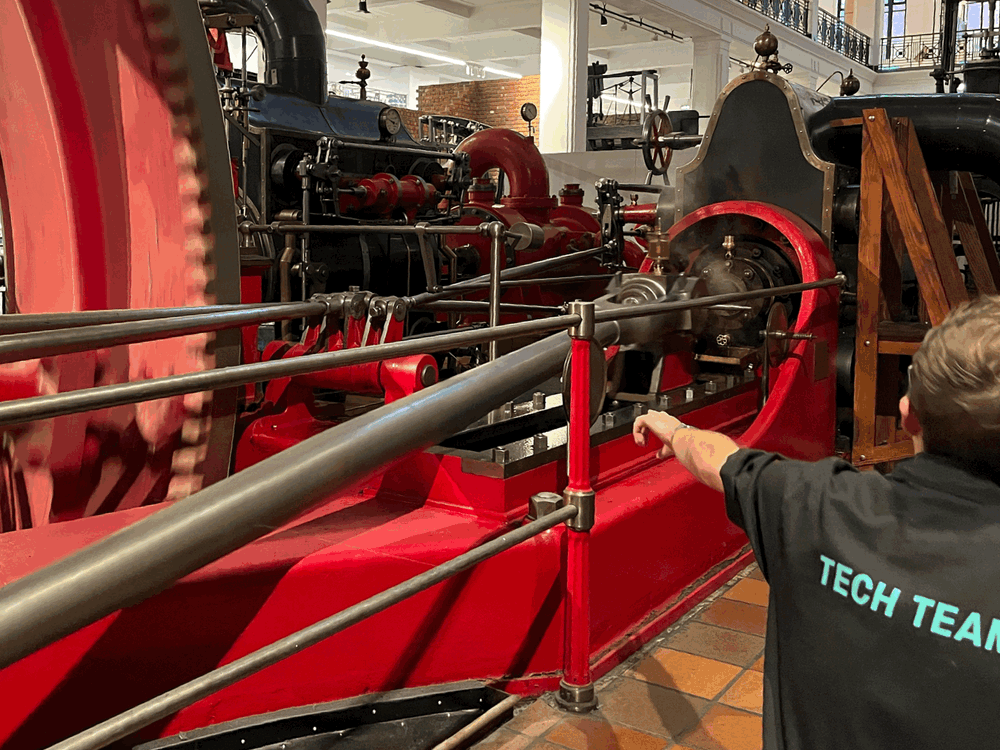Exploration Without Interaction
We were in the Science Museum, me and my 10-year old, looking at the huge Burnley Mill engine as it chugged. We talked about the parts, saw how they were interconnected, wondered about their purpose and function, listened to the noises, watched people as they oiled and tuned, asked questions, read the signs, smelt the hot and oily steel.
We couldn't touch it, of course. Even the people tending to it avoided touching it, mostly. Touching it is dangerous to the toucher, potentially harmful to the machine. We explored the engine nonetheless.
We can explore an artefact without interacting with it.
Let's think about a working software system.
It's an artefact – a made thing – so has history and purpose and utility and risks and versions and problems and (right / wrong) context. It has users and manuals and advertising copy. It lives in a conceptual framework of ideas and expectations, and a technical framework of data and tools and communications, and (right now) is at one moment in probably several lifecycles. It's made of parts, that interact over time and distance within various mediums.It has large chunks that perhaps lie dusty or unused – at this time, and for this system.
As software, it's likely made of data and code, so has defaults and error messages and comments. It's built with languages with idioms and patterns, it imports libraries and exports parts of itself for use, it lives within machines that contain other systems that support and compete. It shows off its ways of use via UIs and APIs and signatures and records. It keeps its information in logs and records and databases, accepts configuration. If it is resilient, it has backups, alternatives and workarounds. It may offer itself in multiple (human) languages, or with several feature sets, or in different media. It may make connections to systems you've never thought of, half a world away.
And we may be able to see or infer how it is affected by its environment; by the distances and technologies that wrap around its parts, by the data it is given, by the reliability of what it depends on.
These things are observable, to us. Each is an explorable interface, most will reward several different approaches to exploration. Each lets us discover and learn about a different perspective. And – if the purpose of our exploration is not only to learn but to look for flaws and surprises – inconsistencies between the models that they engender in our minds may tell us that the system is problematic, that the perspective is inaccurate, or that my model was rubbish.
We're exploring – but perhaps we're not testing the machine as much as we are testing ourselves. We can't change the machine, certainly. We can change how we see it, think of it and describe it.
I saw a coal-fired machine inside a crowded public building, and understood that the fire box was for show only when I recognised that I could not smell burning coal. I read that the machine had been built in 1903 and did not, ahem, have a beam – so could correct the fact ("it's a Victorian beam engine") that I'd confidently spewed. We asked about a part, and discovered that the intimate joints of the whirling, clanking and unstoppably massive limbs of these machines need to be oiled as they work – and that the delicate and mysterious components are vital to the survival of both the machine, and its operators.
There's bugs in them hills. And there's more to finding them than shoving long strings into short input fields.
Exercise: try Exploring Fixed Input.
Subscribers get to see the stuff I wrote that didn't fit here...
Sprue
- It's interesting to think about how we explore, when we can observe, but can't interact directly. Pretty much all exploration outside our planet is done with observation.
- Some observation is by inference only – observed data, accepted maths and tested models inform us about the age and size of the universe, the atomic interactions in supernovae, the behaviour of black holes.
- We might argue that it's all inferred – we might also argue that any observation necessarily changes the object being observed. These are nice distractions, but don't currently have a place here.




